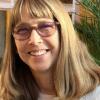Give kids paper and crayons, and they will give you their hearts. At Tucson's Casa Alitas, a Catholic Community Services short-term shelter for immigrant families released from detention, kid's artwork covers the largest wall in the house. Guileless and profound, art by immigrant children puts the border rhetoric of adults to shame.
Many of the immigrant children at Casa Alitas are refugees fleeing the unimaginable. Multiple drawings depicting houses and pets left behind, long roads traveled, and mountains and rivers crossed, testify to the trauma of wholesale familial displacement. As an Alitas volunteer and former art therapist, when I see images of fiery volcanos erupting and great tears filling a sky, I can't help but remember other drawings I have seen by young burn patients who use whatever body part was left unburned, even if that meant their toes to grasp a paint brush or crayon.
At Casa Alitas, artmaking is spontaneous, mostly self-directed, and done on the fly. In the middle of near constant chaos of guests and volunteers, drawing and painting compete with eating at a multi-purpose kitchen table. Once the kids are given art supplies, they grab crayons and press down hard on their paper as if their lives depend on it. They may not be at the house for long, but they will leave their mark nevertheless.
The time-honored symbols children use form a universal vocabulary that spans culture and language. In the sunniest drawings, the Thank you's and Hello my name is… looming clouds and rain can darken blue skies. Winged hearts, perhaps the most common symbol in young immigrant's drawings, rip and tear down the middle like the border itself. Big eyes, drawn wide open, remind the viewer that these kids see everything.
When they finish their drawings, the children seek out the house volunteers and together, we look at their pictures. Many are too young and traumatized to articulate what they have been through, but their artwork speaks for them. Shy kids smile and hand us their papers to hang on the wall. When we manage to find an available space between all the other drawings, they break into open grins. Their story has joined the others. They are no longer alone. They matter.
Years ago, I was given a kid's school notebook found among stands of cactus in the desert near the border. Tucked in the pages was a drawing, a map of the journey to the border; a look at migration through the eyes of a child.
In the drawing, an X-ray view of a hotel that flies the Mexican flag reveals the familiar elements of home: a kitchen, a bedroom, even a T.V. A long winding road leads from the door of the hotel to the border. In the bottom corner of the drawing, a box truck stops at a dark impenetrable wall. On the other side of the border, leafy trees and tall grass beckon.
Another pencil drawing found in a backpack left behind in the sand was a letter a young girl, Marisol, had written to her missing father. On the back of the letter, Marisol drew her complete family: tiny figures of her father, mother and her sister standing together, dwarfed by a large house. Will Marisol's house, devoid of windows with a heavily penciled roof protect the family from being ripped apart again?
During a recent volunteer shift at Casa Alitas, a small teen handed me a crayon drawing of a sparse, faintly-colored desert landscape.
"Desierto?" I asked.
"Si, dos días en el desierto." (Two days in the desert.)
He stared at his drawing.
"No agua, no comida" (no water, no food), he said, his voice barely audible.
It was when I hung the drawing on the wall that he smiled at last. His desert landscape next to the other more colorful drawings — bright flowers and family — blended into a wall of hope: fresh, unrestrained hope. As far as these children have come, after everything they have endured, they still believe with all their hearts that they will get to stay.
[Valarie Lee James, devotional artist, writer, and resident of the Arizona-Mexico borderlands, has been a Benedictine oblate of the Sisters of Perpetual Adoration in Tucson since 2010. A former art therapist, James is grateful for the universal language of art in her volunteer work with immigrants and asylum seekers. She is currently writing a book on art and faith on the border.]






